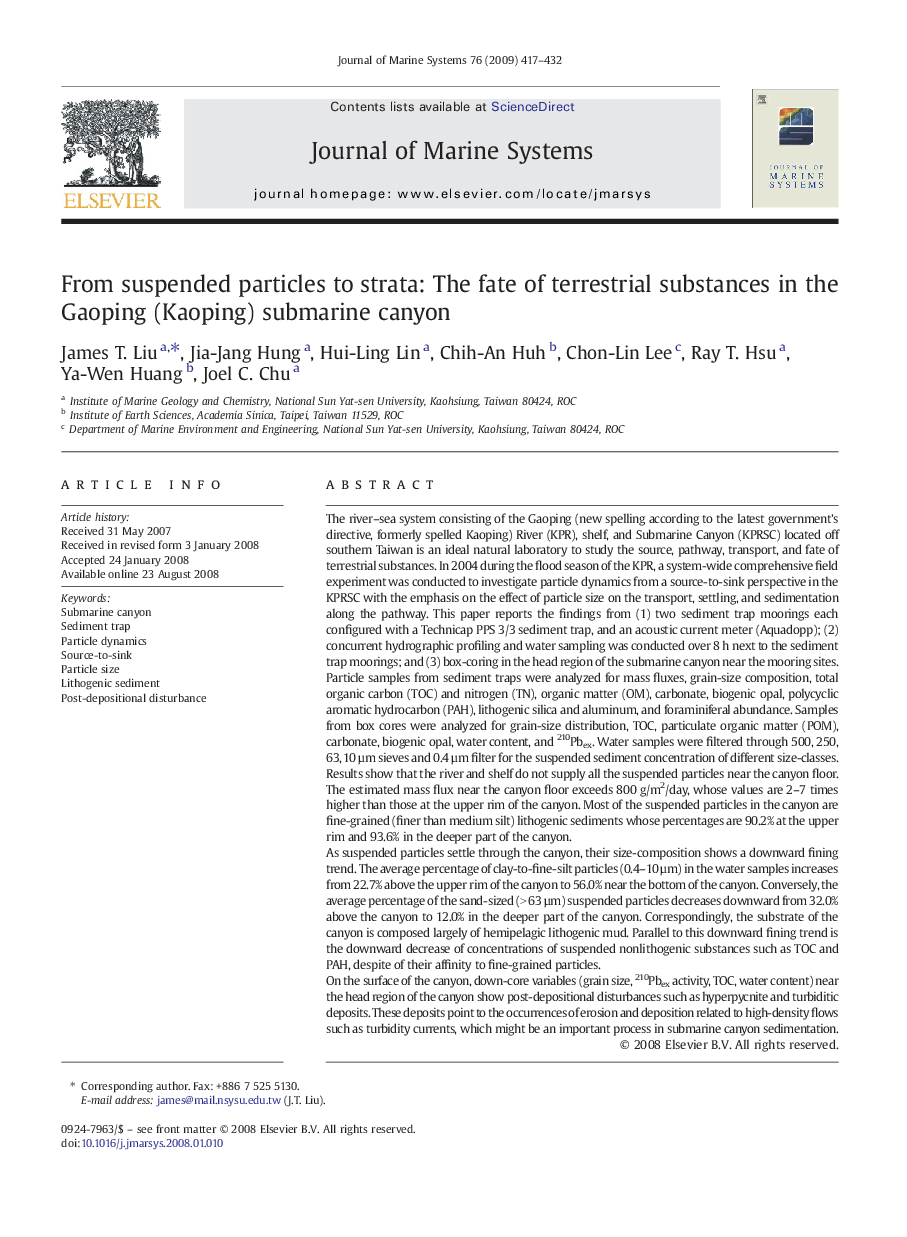| کد مقاله | کد نشریه | سال انتشار | مقاله انگلیسی | نسخه تمام متن |
|---|---|---|---|---|
| 4548786 | 1327929 | 2009 | 16 صفحه PDF | دانلود رایگان |

The river–sea system consisting of the Gaoping (new spelling according to the latest government's directive, formerly spelled Kaoping) River (KPR), shelf, and Submarine Canyon (KPRSC) located off southern Taiwan is an ideal natural laboratory to study the source, pathway, transport, and fate of terrestrial substances. In 2004 during the flood season of the KPR, a system-wide comprehensive field experiment was conducted to investigate particle dynamics from a source-to-sink perspective in the KPRSC with the emphasis on the effect of particle size on the transport, settling, and sedimentation along the pathway. This paper reports the findings from (1) two sediment trap moorings each configured with a Technicap PPS 3/3 sediment trap, and an acoustic current meter (Aquadopp); (2) concurrent hydrographic profiling and water sampling was conducted over 8 h next to the sediment trap moorings; and (3) box-coring in the head region of the submarine canyon near the mooring sites. Particle samples from sediment traps were analyzed for mass fluxes, grain-size composition, total organic carbon (TOC) and nitrogen (TN), organic matter (OM), carbonate, biogenic opal, polycyclic aromatic hydrocarbon (PAH), lithogenic silica and aluminum, and foraminiferal abundance. Samples from box cores were analyzed for grain-size distribution, TOC, particulate organic matter (POM), carbonate, biogenic opal, water content, and 210Pbex. Water samples were filtered through 500, 250, 63, 10 µm sieves and 0.4 µm filter for the suspended sediment concentration of different size-classes.Results show that the river and shelf do not supply all the suspended particles near the canyon floor. The estimated mass flux near the canyon floor exceeds 800 g/m2/day, whose values are 2–7 times higher than those at the upper rim of the canyon. Most of the suspended particles in the canyon are fine-grained (finer than medium silt) lithogenic sediments whose percentages are 90.2% at the upper rim and 93.6% in the deeper part of the canyon.As suspended particles settle through the canyon, their size-composition shows a downward fining trend. The average percentage of clay-to-fine-silt particles (0.4–10 µm) in the water samples increases from 22.7% above the upper rim of the canyon to 56.0% near the bottom of the canyon. Conversely, the average percentage of the sand-sized (> 63 µm) suspended particles decreases downward from 32.0% above the canyon to 12.0% in the deeper part of the canyon. Correspondingly, the substrate of the canyon is composed largely of hemipelagic lithogenic mud. Parallel to this downward fining trend is the downward decrease of concentrations of suspended nonlithogenic substances such as TOC and PAH, despite of their affinity to fine-grained particles.On the surface of the canyon, down-core variables (grain size, 210Pbex activity, TOC, water content) near the head region of the canyon show post-depositional disturbances such as hyperpycnite and turbiditic deposits. These deposits point to the occurrences of erosion and deposition related to high-density flows such as turbidity currents, which might be an important process in submarine canyon sedimentation.
Journal: Journal of Marine Systems - Volume 76, Issue 4, 20 March 2009, Pages 417–432